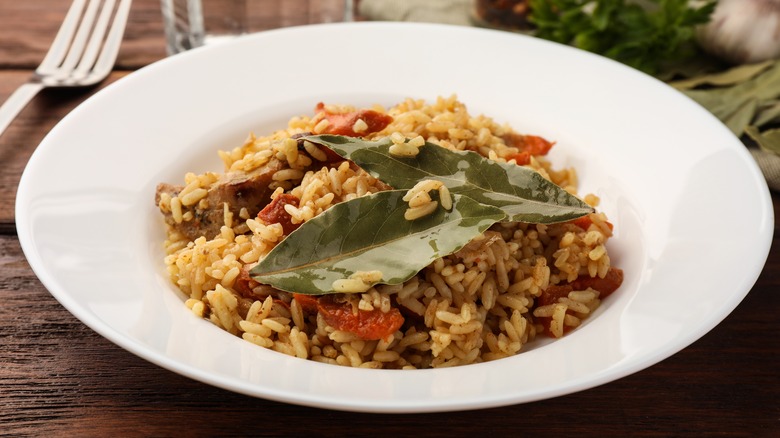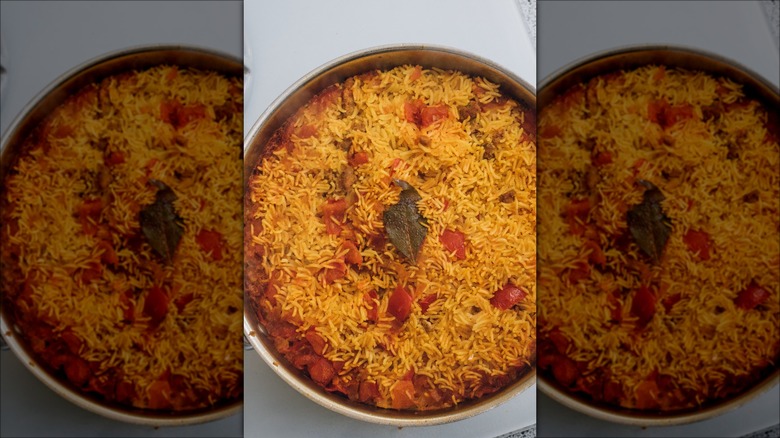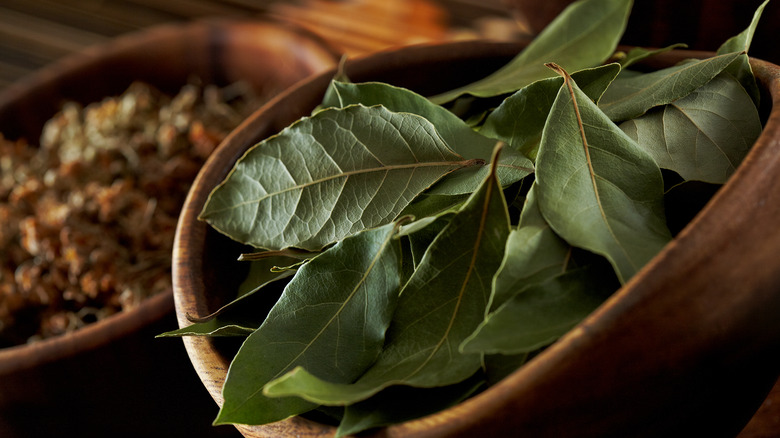The Flavorful Reason You Should Be Adding Bay Leaves To Your Rice
Considered a staple food for more than half of the world's population, rice can be found in kitchens everywhere. While the main classifications are usually white or brown, the plentiful options can go beyond those simplified groups. Even though rice is a common food, boosting the flavor of that simple dish is as easy as adding a bay leaf to the pot. Bay leaves generally produce a background flavor in dishes. Grandma might have added a few to her Sunday sauce that simmered on the stove most of the day. It can be a little earthy, slightly herbal, and a touch spicy. Overall, the taste cannot be duplicated with other herbs and spices.
Adding a bay leaf to rice enhances both the aroma and the flavor. Given that rice tends to be a blank slate, it is a simple, one ingredient enhancement. Overall, the flavor is subtle, but it is never completely overshadowed. In addition, bay leaves work well with other ingredients. From a bright citrus note to a spicy jambalaya, the herb supports all the other flavors in the dish. While that sprinkle of salt to finish a dish might be a chef's kiss, the bay leaf added to the rice pot might be the real secret ingredient that needs to be uncovered.
Simple ways to add bay leaves to rice
While a dried bay leaf might be sitting in the back of your spice rack, it's probably time to purchase a new container and use it to flavor a big pot of rice. To infuse the classic grain with that subtle, earthy note, cooks can add the ingredient before or during the cooking process. First, both dried and fresh bay leaves can be added to the water and rice as it cooks. For fresh bay leaves, consider tying them together in a bouquet or enclosing them in a piece of cheese cloth. Dried leaves can be added whole or through the bouquet method. The sachet adds the flavor and aroma to the rice as it cooks. It is a slow, gentle process, but this method tends to elicit a deeper infusion because the rice and bay leaves cook together longer.
If a more subtle note is wanted, the bay leaves can steep in the cooking water prior to the rice being added to the pot. Although not as pungent as a tea, the water will have that underlying woodsy note, which will be absorbed by the rice as it cooks. The key to using bay leaves in rice is that the herb needs to be introduced during the cooking process.
The key item to remember when adding bay leaves to rice
While the bay leaf can add flavor unlike other herbs and spices, the key to using this ingredient correctly in rice, or any dish, is to remove it prior to serving. The reason is not the unappealing appearance of a big, dried brown leaf centered on the plate. The brittle, almost bone-like texture is unpleasant and could be dangerous if you or your guests were to choke on it. Since few people would want to gnaw on a twig, it is best to ditch the bay leaf before the dish hits the table.
In addition, bay leaves should be cooked — but not endlessly — in a dish. Both fresh and dried bay leaves benefit from heat to allow its flavor and aroma to be released. Without that heat exposure, the bay leaf lacks any real flavor depth. While cooking is beneficial, too much time close to the flame can be detrimental. If left too long, the herb can turn bitter. Although it might take hours for this flavor transition to happen, it is a hard mistake to fix.


